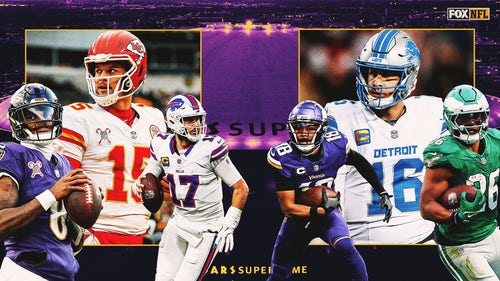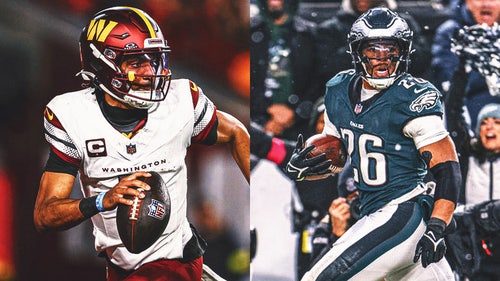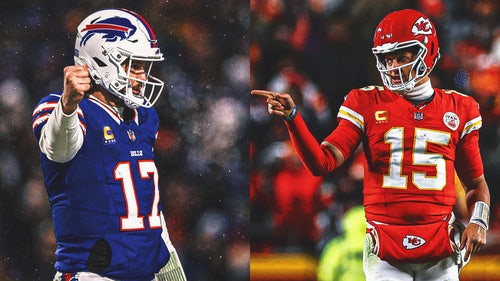
How Dallas Wasted A Great Offensive Line
By Geoff Schwartz
FOX Sports NFL analyst
An NFL team is only as good as its offensive line — well, at least according to this former NFL offensive lineman.
If the goal is winning Super Bowls, a franchise must invest in and develop its offensive line. It’s the heartbeat of the team: Five guys working together to physically dominate the opponent.

The Cowboys offensive line of Doug Free (68), Zack Martin (70), Ronald Leary (65), Travis Frederick (72) and Tyron Smith (77) was once the most dominating unit in the NFL.
While it’s nearly impossible to win in the NFL without this unit being one of the best, it’s also nearly impossible to not win much of anything when you own one of the league's best units for nearly a decade.
This is the story how the Dallas Cowboys squandered an opportunity to win a championship with one of the best offensive lines I’ve seen.
The window for success in the NFL closes quickly — unless your team has Tom Brady and Bill Belichick — and you must strike while the iron is hot. The Cowboys during the last half of the 2010s, unfortunately, are an example of a team that wasted its talent, especially up front.

From 2014 to 2017, Dallas owned the unquestioned best offensive line in football, featuring multiple future Hall of Famers, All-Pros and Pro Bowlers.
The Cowboys dominated the league in both pass protection, ranking in the top two in 2014 and 2015 by Pro Football Focus, and run blocking, where they mashed opposing defenses. In the simplest of terms, they did not finish outside the top five in yards per carry in those four seasons.
Dallas' rushing DVOA ranked in the top three for three of those four seasons, while ranking 10th in the fourth campaign.
According to Football Outsiders' Adjusted Line Yards metric, which is directly attributed to the big fellas up front, the Cowboys did not finish outside the top six in those four seasons.

The injury to Zack Martin in a Thanksgiving Day game against Washington was symbolic of the decline of the one of the NFL's best position groups.
Unfortunately for the Cowboys, the success of their big boys only produced two playoff appearances and a single postseason victory.
So, how did the Cowboys build this monster for it only to be torn down piece by piece? It starts with drafting the right guys, developing their talent with the right coaching and keeping them healthy.
Drafting offensive linemen can be a tricky business. College success does not translate into NFL success for a variety of reasons, including the college schemes and techniques, which are often very different between the levels.
With less practice time in the NFL, it’s hard to develop players when wholesale technique changes are needed. It’s important to draft offensive linemen — especially early in the draft when you’re expecting them to play fairly quickly — from well-known offensive-line factories. The Cowboys followed this plan and hit a gold mine.
The anchor for those Dallas units was future Hall of Famer Tyron Smith. The USC product was drafted by the Cowboys in the first round of the 2011 NFL Draft and immediately started 16 games.
It was easy to see from the start of his career Smith was something special, even as he worked through some rookie struggles. After allowing eight sacks on 641 pass-protection snaps in 2011, Smith allowed 19 over his next 4,591 snaps, spanning from 2012 to present.
Smith has a prototypical body for an offensive lineman, with thick legs, long arms, giant hands and excellent feet. When you watch him play, it looks easy. He swallows up defenders quickly, allowing his running backs room to run and his quarterbacks the ability to drop back without fear of getting hit from behind. Smith was named the All-Pro left tackle in 2014-17.
The Cowboys added to their offensive line in 2013, drafting their stalwart at center, Travis Frederick, with the 31st pick in the first round. Frederick immediately became the rock for this unit. A center must be quick but strong at the point of attack. In the running game, centers are often blocking defenders that outweigh them by 30 to 40 pounds.
Centers also must be high mental processors, as they are required to read a defense and identify where the offense is moving. Frederick was once the best in the game, making All-Pro in 2016 and being chosen for the Pro Bowl from 2014-17.
Heading into the 2014 season, Dallas' offensive line was set at four positions. The Cowboys added undrafted free-agent guard Ronald Leary in 2012, and he won the starting job in 2013. Leary was an underappreciated member of this offensive line, and his value wasn’t noticed until he left for Denver before the 2017 season.
Also, the Cowboys had Doug Free at right tackle, a veteran who was drafted back in 2007. He was the "old man" of the unit but clearly the mentor for these young players. Free was tough, reliable and got the job done.
These four players alone would make an outstanding offensive line, but the Cowboys added one more key piece in 2014.
Zack Martin has been the best guard in football since he was drafted with the 16th pick in the NFL draft in 2014. He played left tackle at Notre Dame, but was moved inside to right guard, where he lives now. In his first six seasons, he made the All-Pro team in all six of them. He was part of the 2010 NFL All-Decade Team despite not being in the league from 2010-2014.
There’s nothing Martin doesn’t do well. He’s outstanding in pass protection, rarely allowing more than 15 total pressures in a season. In the running game, there’s no better guard on the move.
This clip is from last season, where every big run for Elliott was behind No. 70:
This talented unit needed a skilled teacher, and they got it with Bill Callahan. He was the offensive line coach from 2012 to 2014, nurturing this young unit into something special. Callahan is now doing the same thing in Cleveland with the 2020 Browns.
After leaving for the same position in Washington, Callahan's understudy, assistant offensive line coach Frank Pollack, took over and led this group until 2017. It’s impossible to have a good offensive line without good coaches, and these two men deserve credit.
The offensive line coach does more than teach technique, they design the running game, for which Dallas dominated for four straight years.
An offensive line unit can be talented and well-coached, but they need their lineman to stay together as a unit. Health can be a bigger factor to success than talent.
The Cowboys couldn’t have gotten better injury "luck" over these four seasons, and even when their linemen were injured, the team was ready. Smith played 58 of 64 regular-season games, while both Frederick and Martin played every game. Leary was healthy for most of 2014, but was injured early in 2015. Luckily for the Cowboys, they had undrafted rookie La’el Collins on the roster waiting to fill in.
If you don’t remember the drama, Collins was a first-round lock before legal issues (which resulted in no charges) moved him off most draft boards. The Cowboys scooped him up and landed a first-round talent.
After filling in for Leary in 2015, Collins was injured in 2016 and then replaced Free at right tackle in 2017, sliding outside to his more natural position.
With this unit humming, the Cowboys should have gotten deeper into the playoffs. In 2014, they won their first playoff game since 2009 before losing to Aaron Rodgers in the divisional round in a game remembered for the controversial call on Dez Bryant's non-catch.
Hopes were high for success in 2015 until Tony Romo was injured in Week 2, missing nine weeks. Romo returned briefly before getting injured again during their Thanksgiving Day game. A lost season.
The 2016 season began with the Cowboys expecting Romo to lead a loaded offense. But after Romo was injured in the preseason, rookie Dak Prescott took over, and Dallas never looked back.
The Cowboys won the NFC East at 13-3, but once again couldn’t finish the deal, losing to the Packers again in the divisional round. In 2017, Dallas went 9-7, but failed to reach the playoffs as Prescott regressed just a bit.
The failures of the Cowboys are usually not associated with the offense during this time, as the defense let them down in the playoffs. But nonetheless, Dallas had multiple seasons when having the best offensive line in football didn’t lead to playoff success.
The undoing of the Cowboys offensive line started in 2018 when Frederick missed the season with Guillain-Barré syndrome, and the Cowboys drafted Connor Williams to play left tackle, who never materialized into what they hoped he’d be.
Dallas also replaced Pollack with Paul Alexander, a longtime line coach with the Bengals. The fit wasn’t ideal, and Alexander was released from his duties midway through the season and replaced by Frank Colombo.
Colombo was able to right the ship a bit. The unit, while not statistically as grand as the previous four seasons, played well to finish 2018. But with Frederick missing, Williams not playing well and Smith started to get hit with the injury bug, the line was crumbling.
In 2019, Frederick returned to the lineup, and while that helped bolster the unit, it was clear he wasn’t the same player. Williams had the same issues at left guard, and Smith played through nagging injuries in his 13 starts. Nonetheless, with Martin and Collins, the Cowboys saw an improvement in their entire operation, once again finishing in the top three in rushing DVOA and eighth in pass blocking grade, according to Pro Football Focus.
Then came the 2020 season, where the wheels are off the wagon.
Frederick retired before the season, dealing a huge blow to the line. Collins was put on injured reserve before the first game of the season. Smith only played two games. Martin, who had missed two games in his first six seasons, played only 10 games, often playing offensive tackle because of injuries.
What once was the best offensive line football was a shell of itself. The Cowboys missed their window of opportunity with this unit.
I'm sure they hope with the return of a healthy Smith, Martin and Collins, they can return to the glory years of 2014-17. However, history shows that likely will not be the case.
The best offensive line in football is a distant memory.
Geoff Schwartz played nine seasons in the NFL for five different teams. He started at right tackle for the University of Oregon for three seasons and was a second-team All-Pac-12 selection his senior year. He is an NFL analyst for FOX Sports.









